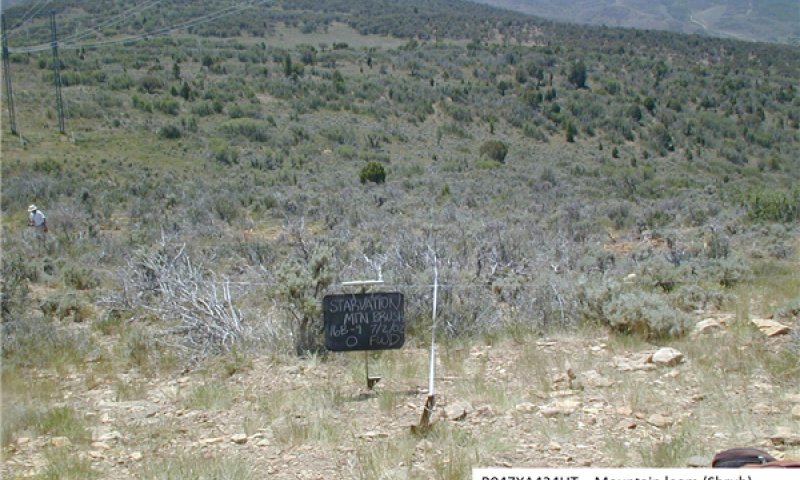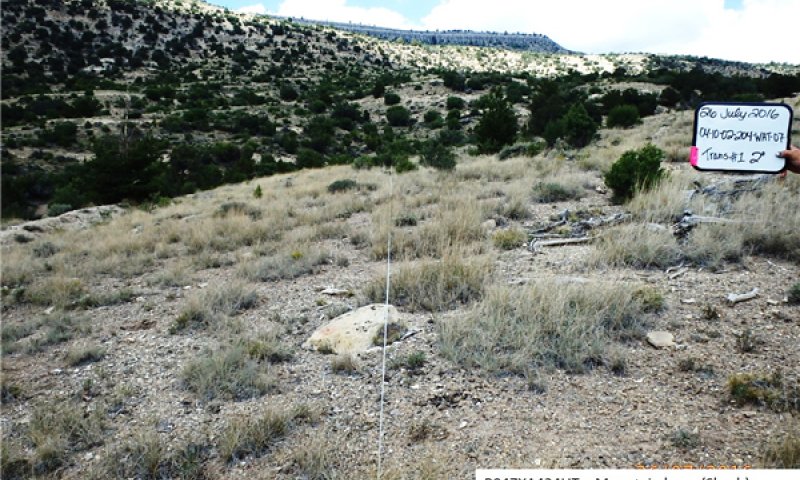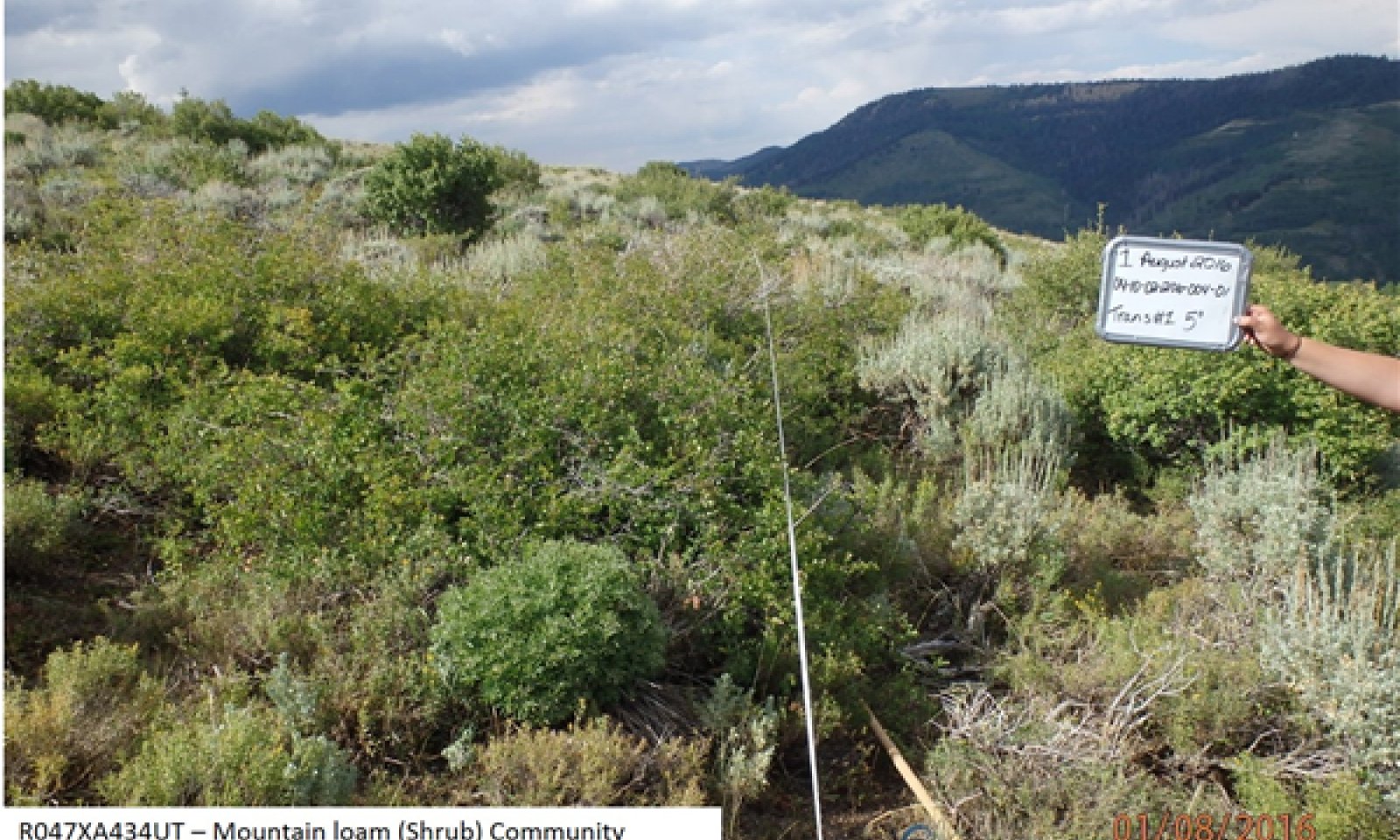Ecological dynamics
It is impossible to determine in any quantitative detail the Historic Climax Plant Community (HCPC) for this ecological site because of the lack of direct historical documentation preceding all human influence. In some areas, the earliest reports of dominant plants include the cadastral survey conducted by the General Land Office, which began in the late 19th century for this area (Galatowitsch 1990). However, up to the 1870s the Shoshone Indians, prevalent in northern Utah and neighboring states, grazed horses and set fires to alter the vegetation for their needs (Parson 1996). In the 1860s, Europeans brought cattle and horses to the area, grazing large numbers of them on unfenced parcels year-long (Parson 1996). Itinerant and local sheep flocks followed, largely replacing cattle as the browse component increased.
Below is a State and Transition Model diagram to illustrate the “phases” (common plant communities), and “states” (aggregations of those plant communities) that can occur on the site. Differences between phases and states depend primarily upon observations of a range of disturbance histories in areas where this ESD is represented. These situations include grazing gradients to water sources, fence-line contrasts, patches with differing dates of fire, herbicide treatment, tillage, etc. Reference State 1 illustrates the common plant communities that probably existed just prior to European settlement.
The major successional pathways within states, (“community pathways”) are indicated by arrows between phases. “Transitions” are indicated by arrows between states. The drivers of these changes are indicated in codes decipherable by referring to the legend at the bottom of the page and by reading the detailed narratives that follow the diagram. The transition between Reference State 1 and State 2 is considered irreversible because of the naturalization of exotic species of both flora and fauna, possible extinction of native species, and climate change. There may have also been accelerated soil erosion.
When available, monitoring data (of various types) were employed to validate more subjective inferences made in this diagram. See the complete files in the office of the State Range Conservationist for more detail.
Plant Community Narratives:
The plant communities shown in this State and Transition Model may not represent every possibility, but are probably the most prevalent and recurring plant communities. As more monitoring data are collected, some phases or states may be revised, removed, and/or new ones may be added. None of these plant communities should necessarily be thought of as “Desired Plant Communities.” According to the USDA NRCS National Range & Pasture Handbook (USDA-NRCS 2003), Desired Plant Communities (DPC’s) will be determined by the decision-makers and will meet minimum quality criteria established by the NRCS. The main purpose for including descriptions of a plant community is to capture the current knowledge at the time of this revision.
As range condition deteriorates due to overgrazing, slender wheatgrass and bluebunch wheatgrass decrease while mountain big sagebrush increases. Burning the vegetation causes mountain big sagebrush to decrease in density and grass, rabbitbrush, snowberry and serviceberry to increase. Plant species not a part of the climax plant community that are most likely to invade the site if plant cover deteriorates are: cheatgrass, annual forbs, milkweed, stickseed, tarweed, and snakeweed.
State 1
Reference State
The Reference State is a description of this ecological site just prior to Euro-American settlement but long after the arrival of Native Americans. The description of the Reference State was determined by NRCS Soil Survey Type Site Location information and familiarity with rangeland relict areas where they exist. The least modified plant community (1.1) within the Reference State would have been a sagebrush-dominated stand with mountain big sagebrush (Artemisia tridentate spp. vaseyana), mountain snowberry (Symphoricarpos oreophilus) and associated bunch grasses such as bluebunch wheatgrass (Pseudoroegeneria spicata), Nevada bluegrass (Poa secunda) and slender wheatgrass (Elymus trachycaulus). Forbs such as arrowleaf balsamroot (Balsamorhiza sagittata), sticky purple geranium (Geranium viscosissimum) and fleabane (Erigeron sp.) would be present. Fire is believed to be the dominant disturbance force in natural big sagebrush communities. The reference plant community (1.1) would have been relatively stable with occasional use by wildlife. Following a natural fire (1.1a) and depending on the severity, would have killed most if not all of the sagebrush favoring the sprouting shrubs and bunchgrasses (1.2). Over time and without any further disturbances (1.2a) sagebrush and other non-sprouting shrubs would slowly come back into the site (1.3), however the sprouting shrubs and bunch grasses would still dominate the site. If there were another fire to occur on the site (1.3a) the site would return to community phase 1.2. If community phase 1.3 continued to experience no disturbances over a longer period of time (1.3b) it would eventually show a co-dominance between mountain big sagebrush and the other shrubs on the site. A more complete list of species by lifeform for the Reference State is available in the accompanying tables in the “Plant Community Composition by Weight and Percentage” section of this document.
Community 1.1
Mountain big sagebrush/other shrubs/ perennial grasses

Figure 6. CP1.1
The least modified plant community within the Reference State would have been a mountain big sagebrush-dominated with associated deciduous shrubs such as mountain snowberry, antelope bitterbrush, serviceberry and associated perennial grasses such as bluebunch wheatgrass and slender wheatgrass. Arrowleaf balsamroot, sticky purple geranium and erigeron sp. would have been the commonly associated forbs. Percent composition would have been 45 percent shrubs, 45 percent grasses and 15 percent forbs.
Table 5. Annual production by plant type
| Plant type |
Low
(lb/acre) |
Representative value
(lb/acre) |
High
(lb/acre) |
| Grass/Grasslike |
698 |
923 |
1148 |
| Shrub/Vine |
698 |
923 |
1148 |
| Forb |
155 |
205 |
255 |
| Total |
1551 |
2051 |
2551 |
Table 6. Ground cover
| Tree foliar cover |
0%
|
| Shrub/vine/liana foliar cover |
24-26%
|
| Grass/grasslike foliar cover |
34-36%
|
| Forb foliar cover |
9-11%
|
| Non-vascular plants |
0%
|
| Biological crusts |
0%
|
| Litter |
0%
|
| Surface fragments >0.25" and <=3" |
0%
|
| Surface fragments >3" |
0%
|
| Bedrock |
0%
|
| Water |
0%
|
| Bare ground |
0%
|
Table 7. Canopy structure (% cover)
| Height Above Ground (ft) |
Tree |
Shrub/Vine |
Grass/
Grasslike |
Forb |
| <0.5 |
– |
– |
– |
– |
| >0.5 <= 1 |
– |
– |
– |
9-11% |
| >1 <= 2 |
– |
– |
34-36% |
– |
| >2 <= 4.5 |
– |
24-26% |
– |
– |
| >4.5 <= 13 |
– |
– |
– |
– |
| >13 <= 40 |
– |
– |
– |
– |
| >40 <= 80 |
– |
– |
– |
– |
| >80 <= 120 |
– |
– |
– |
– |
| >120 |
– |
– |
– |
– |
Community 1.2
Sprouting shrubs with perennial bunch grasses.
Fire is a naturally occurring disturbance on this site and would have kept shrubs like mountain big sagebrush and antelope bitterbrush less dominant. Sprouting shrubs like mountain snowberry and serviceberry and perennial grasses would have become the dominant aspect of this site.
Community 1.3
Non-sprouting shrubs start becoming re-established
Non-sprouting shrubs start becoming re-established from seed over time. Sprouting shrubs and perennial grasses are still the dominant aspect of this site.
Pathway 1.1a
Community 1.1 to 1.2
A naturally occurring fire would have killed all the non-sprouting shrubs like mountain big sagebrush. As the site recovered, it would be converted to the sprouting shrubs with perennial bunchgrasses community.
Pathway 1.2a
Community 1.2 to 1.3
Over time and without the occurrence of a natural disturbance, such as fire, non-sprouting shrubs like mountain big sagebrush, antelope bitterbrush and alderleaf mountain mahogany would become re-established on the site.
Pathway 1.3b
Community 1.3 to 1.1
Over time and with the absence of a natural disturbance, like fire, the non-sprouting shrubs will continue becoming more abundant to a point where they are co-dominant with the sprouting shrubs.
Pathway 1.3a
Community 1.3 to 1.2
In the event that there is another natural disturbance, like a fire, the site would return to the sprouting shrubs with perennial bunch grasses community.
State 2
Current Potential
State 2 is identical to State 1 in form and function, with the exception of the presence of non-native plants and animals, possible extinctions of native species, and a different climate. State 2 is a description of the ecological site shortly following Euro-American settlement, which can be regarded as the current potential. The least modified plant community (2.1) within State 2 is a sagebrush (Artemisia tridentate spp. vaseyana) dominated state with mountain snowberry (Symphoricarpos oreophilus) and associated bunch grasses such as bluebunch wheatgrass (Pseudoroegeneria spicata), Nevada bluegrass (Poa secunda) and slender wheatgrass (Elymus trachycaulus). Forbs such as arrowleaf balsamroot (Balsamorhiza sagittata), sticky purple geranium (Geranium viscosissimum) and fleabane (Erigeron sp.) would be present. A common non-native species in this state is cheatgrass. Fire is believed to be the dominant disturbance force in natural big sagebrush communities. Following brush management or fire (2.1a) and depending on the severity, would have killed most if not all of the sagebrush, and other non-sprouting shrubs, favoring the sprouting shrubs and bunchgrasses (2.2). This plant community is relatively stable under mixed use by wildlife and livestock. However, heavy utilization by bison, elk, horses, and domestic cattle on these sites during the growing season (2.1b) would deplete the grasses and deciduous shrubs creating site that is dominated by mountain big sagebrush (2.3). In community 2.2, when management, such as prescribed grazing, can be combined with time (2.2a) to allow the site to recover returning to community 2.1. However if the community continues to be over utilized by both wildlife and domestic livestock, and possibly in combination with a natural or man caused disturbance (2.2b) this community (2.2) can be degraded to community 2.4 which is dominated by rhizomatous grasses with unpalatable sprouting shrubs and forbs. In community 2.3 when management, such as prescribed grazing coupled with time, (2.3a) the sprouting shrubs and perennial grasses can have an opportunity to recover and recolonize the site and return to community 2.1. In community 2.3, when it experiences a disturbance such as brush management or fire, coupled with management like prescribed grazing (2.3b) it can drive the site to a more stable and diverse community 2.2. However, when community 2.3 continues to be over utilized and this is coupled with a disturbance such as brush management or fire (2.3c) it can drive the site to an undesirable community 2.4.
Community 2.1
Mountain big sagebrush with perennial grasses and deciduous
The least modified community within the mountain big sagebrush/deciduous shrub/introduced state. This is a mountain big sagebrush dominated community with an abundance of deciduous shrubs such as mountain snowberry, antelope bitterbrush and serviceberry. Community is also characterized by an abundance of native perennial grasses such as, bluebunch wheatgrass, slender wheatgrass and Nevada bluegrass. Associated forbs on this site may consist of arrowleaf balsamroot, sticky purple geranium and erigeron sp. Introduced species likely to occur on this site are cheatgrass, annual forbs, milkweed and stickseed.
Community 2.2
Sprouting shrubs with perennial grasses with introduced annuals present
This community represents what the site would look like following brush management or a natural or prescribed fire. Depending on the severity of the fire/management practice, some or all of the non-sprouting shrubs would be killed. This would open up resources for the sprouting shrubs and native perennial grasses subsequently they would be the dominant aspect of the site.
Community 2.3
Depauperate sagebrush with conifers possibly present
This community represents what the site would look like following a long period of over grazing and browsing. The more palatable species would be heavily utilized giving a competitive advantage to species such as mountain big sagebrush. Over time sagebrush would be the dominant aspect of the site with a low diversity of the other native species that normally occur on the site.
Community 2.4
Rhizomatous grasses with unpalatable sprouting shrubs and forbs with low growing grasses
This community represents the site when there has been continued overgrazing/browsing for an extended period of time, followed by a disturbance such as a brush management treatment or natural/prescribed fire. Species diversity was already low (2.3). The overutilization of the desirable native vegetation coupled with the fire has reduced the site to unpalatable sprouting shrubs and forbs along with low growing grasses.
Pathway 2.1a
Community 2.1 to 2.2
A naturally occurring fire would have killed all the non-sprouting shrubs like mountain big sagebrush. As the site recovered, it would be converted to the sprouting shrubs with perennial bunchgrasses community.
Pathway 2.1a
Community 2.2 to 2.1
Over time and without the occurrence of a natural disturbance, such as fire, non-sprouting shrubs like mountain big sagebrush, antelope bitterbrush and alderleaf mountain mahogany would become re-established on the site.
Pathway 2.3b
Community 2.3 to 2.1
Over time and with the absence of a natural disturbance, like fire, the non-sprouting shrubs will continue becoming more abundant to a point where they are co-dominant with the sprouting shrubs.
Pathway 2.3a
Community 2.3 to 2.2
In the event that there is another natural disturbance, like a fire, the site would return to the sprouting shrubs with perennial bunch grasses community.
Pathway 2.4a
Community 2.4 to 2.2
This pathway represents that over time, along with prescribed grazing that the sprouting shrubs and native perennial grasses would eventually re-establish and return the site back to community 2.2.
State 3
Seeded State
This State occurs where historic excessive livestock grazing reduced canopy cover, and in an attempt to prevent any additional excessive erosion it was intentionally seeded with species such as smooth brome and/or crested wheatgrass. Do to the decreased canopy cover and increased erosion, and rangeland seeding is utilized, either rangeland drilled or aerial application with predominately introduced species.
Community 3.1
Range seeding with perennial introduced species

Figure 8. CP3.1

Figure 9. CP3.1_2
This community represents a time shortly following a brush management treatment/fire in addition to the range seeding. Non-sprouting shrubs have been greatly reduced and sprouting shrubs have not had adequate time to become re-established. Introduced and native grass species with a few sprouting shrubs dominate the site.
Community 3.2
Sprouting shrubs becoming co-dominant with perennial grasses
This community phase represents the site over a 5 to 10 year period of time under normal climatic conditions. The desirable sprouting shrubs have had adequate time to re-establish and become co-dominant with the perennial grasses. Non-sprouting shrubs have also started to re-establish on the site as well. It is imperative that prescribed grazing must be implemented in order for this community to be persist.
Pathway 3.1a
Community 3.1 to 3.2
Over an extended period of time and in combination with prescribed grazing, the native desirable sprouting shrubs begin to become well established.
Transition T1a
State 1 to 2
The simultaneous introduction of exotic species, both plants and animals, and possible extinctions of native flora and fauna, along with climate change, will cause State 1 to transition to State 2. A return pathway back to State 1 would be impracticable because of these issues.
Transition T2a
State 2 to 3
When land managers or landowners have made the decision that the herbaceous understory species are so depleted and undesirable, and the biological, hydrological and soil resources are at risk, introduced and native perennial grasses are utilized in a range seeding. This often occurs in combination with a natural/prescribed fire or other brush management treatment.





